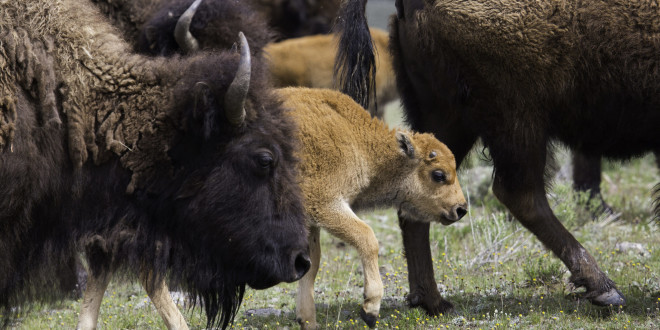Yellowstone officials have backed down from their expected quota for bison management this year—scrapping the proposed number entirely in fact.
At last indication, the Park was firm on culling 1,000 individuals—mostly calves and females—under this year’s version of the Interagency Bison Management Plan. After meeting in Chico Hot Springs today, however, the agencies and tribal representatives reached what the Bozeman Daily Chronicle called “something of an impasse.”
After Park officials brought up delaying trapping until February 15 and eliminating a target number of bison to be taken either by hunting or slaughtered for research, some tribal governments asked trapping to be delayed until late March. In addition, several tribes demanded the previous bison quota be lowered. The Confederated Salish and Kootenai Tribes asked for 800 to 900 while one representative from the Nez Perce Tribe went even lower, suggesting 600 to 700. At that point, the numbers went out the window. From the Chronicle:
“What we’re saying here is everyone is willing to strive to a decreasing population,” said Tom McDonald of the CSKT, coining a term that became the group’s new, squishier goal: managing for a decreasing population.
It moves bison managers away from setting a numeric goal and gives them some discretion, setting neither a goal nor a limit on the number they want to remove. A graphic from Yellowstone National Park shown at the meeting indicated at least 600 bison would have to be removed to keep the population stable or decrease it.
While the IBMP partners agreed on that front, there was still disagreement over when to start trapping. The four bison hunting tribes in Montana suggested delaying trapping until March 31, which would maximize their time available for hunting. Park officials countered by saying a delay in trapping that late would basically end trapping for the year; since cows generally give birth in late spring and early summer, officials don’t want to risk capturing or slaughtering pregnant bison. From the Chronicle:
Carl Scheeler, wildlife program manager for the Confederated Tribes of the Umatilla Indian Reservation, presented the trapping delay plan, which also limited the number of days tribe members could hunt during the season. He said capturing bison harmed opportunity for hunters.
“If we have bison in that trap during the hunting season they are not available for the hunters,” Scheeler said.
Yellowstone Superintendent Dan Wenk offered to delay trapping until Feb. 15, depending on how many animals had been killed in the hunting season, meaning that if hunters killed enough bison, trapping could be delayed even more.
He said it represented a “recognition on our part that if hunter success is high, we don’t have to trap.”
Wenk’s idea got support from representatives of the U.S. Forest Service; Montana Fish, Wildlife and Parks; Montana Department of Livestock, the U.S. Department of Agriculture and the InterTribal Buffalo Council.
But Quincy Ellenwood, representing the Nez Perce, said Feb. 15 was too early, citing some of the same reasons Scheeler did. He eventually agreed to take the idea of Feb. 15 to his tribal council, though he added that he didn’t know what they would say.
Tom McDonald, representing the Confederated Salish Kootenai Tribes, also agreed to take the proposal back to his tribal council for approval.
The tribes — the Shoshone Bannock and the Confederated Tribes of the Umatilla Indian Reservation, in addition to the CSKT and Nez Perce — are expected to respond by Dec. 8.
The IBMP, which pulls together state, federal, and tribal representatives under the banner of managing Yellowstone’s bison population during the winter, must be discussed and finalized by December 31 each year. If representatives cannot reach an agreement over management guidelines, the previous year’s plan will be used.
 Yellowstone Insider Your Complete Guide to America's First National Park
Yellowstone Insider Your Complete Guide to America's First National Park





